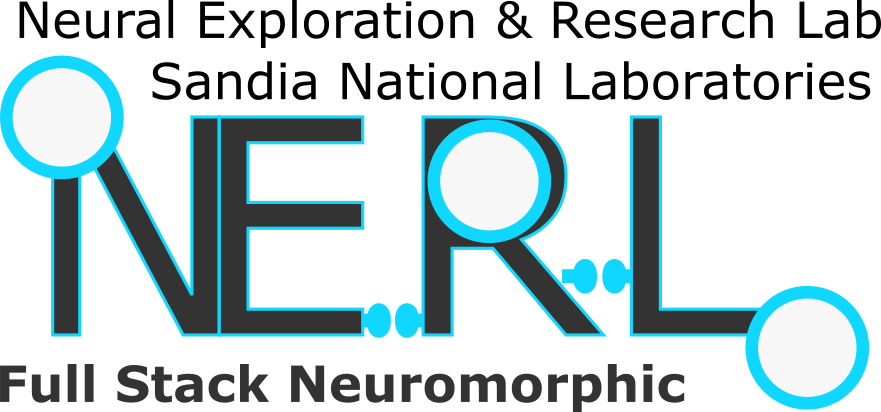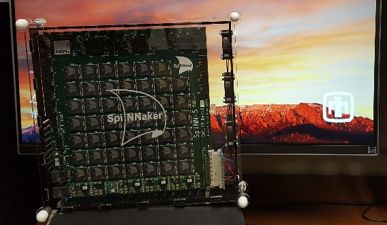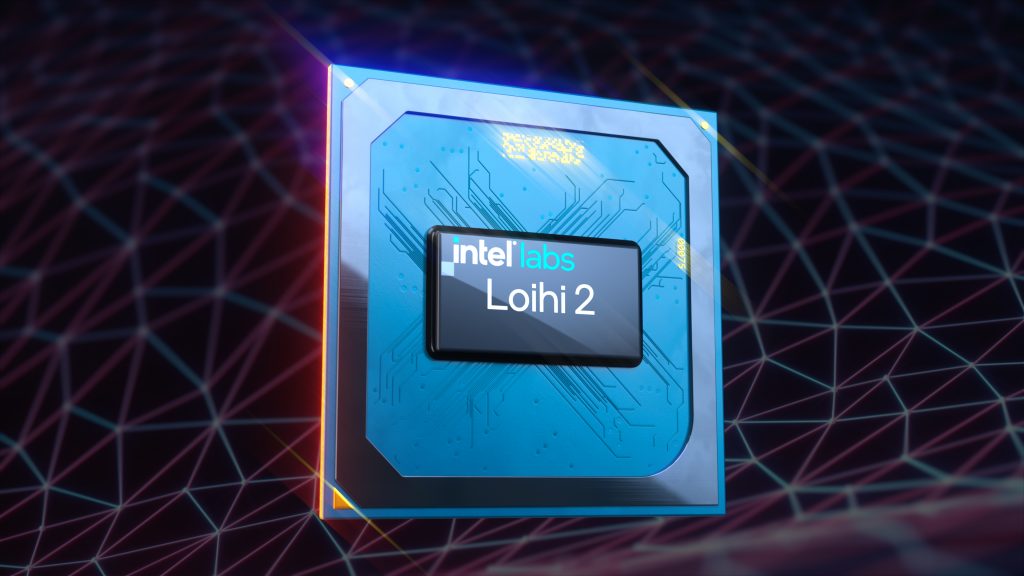
NERL Overview
Sandia’s Neural Exploration & Research Laboratory enables researchers to explore the boundaries of neural computation. The research conducted in the lab evaluates what is possible
The SNL NERL facility enables researchers to explore the boundaries of neural computation. The research conducted in the lab evaluates what is possible with neural hardware and software for national security benefit and the advancement of basic research.
Current areas of NERL research include:
• Machine Learning and Deep Learning
• Microelectronics Co-Design
• Neural Computing and Applications to High Performance Computing (HPC)
• Computational and Mathematical Neuroscience
• Reinforcement Learning
• Remote Sensing
• Edge Sensing and Processing
NERL Hardware
NERL includes a variety of neuromorphic hardware platforms that can be used for comparative benchmarking and architecture exploration. This neuromorphic research capability has enabled relationships with various academic institutions and industry partners that are designing and fabricating neuromorphic computing hardware including:

SpiNNaker 48
One of a few in North America

Intel Loihi
Generations 1 & 2
To test new hardware, NERL relies on a suite of neural “mini-apps” that assist researchers in understanding, predicting, and imporving neuromorphic computing technologies. These Sandia-developed programs include neuromorphic random walks, neural sparse coding, and neural graph analysis.
- C.M. Vineyard, S. Cardwell, F. Chance, S.S. Musuvathy, F. Rothganger, W.M. Severa, J. Smith, C. Teeter, F. Wang and J.B. Aimone, “Neural Mini-Apps as a Tool for Neuromorphic Computing Insight”, ” In Neuro-Inspired Computational Elements Conference, Neuro-Inspired Computational Elements (NICE), 2022, pp. 40-49.
- J.B. Aimone, P. Date, G. Fonseca-Guerra, K. Hamilton, K. Henke, B. Kay, G. Kenyon, et al., “A review of non-cognitive applications for neuromorphic computing“, Neuromorphic Computing and Engineering”, Vol. 2, Issue 3, Sept. 2022.
- J.D. Smith, A.J. Hill, L.E. Reeder, B.C. Franke, R. B. Lehoucq, O. Parekh, W.M. Severa, and J.B. Aimone, “Neuromorphic scaling advantages for energy-efficient random walk computations“, Nature Electronics 5, no. 2, pp.102-112, Feb 2022.
- L. Francios, E.J. Fuller, C.M. Teeter and C.M. Vineyard, “High accuracy single-layer free-space diffractive neuromorphic classifiers for spatially incoherent light“, Optica Express 30, no. 8, 12510-12520, April 2022.
- J.B. Aimone, A.J. Hill, W.M. Severa and C.M. Vineyard, “Spiking Neural Streaming Binary Arithmetic”, International Conference on Rebooting Computing (ICRC), Los Alamitos, CA, 2021, pp. 79-83. IEEE, 2021.
- J.B. Aimone, Y. Ho, O. Parekh, C.A. Phillips, A. Pinar, W.M. Severa and Y. Wang, “Provable advantages for graph algorithms in spiking neural networks“, In Proceedings of the 33rd ACM Symposium on Parallelism in Algorithms and Architectures, 2021, pp. 35-47.
- C.M. Vineyard, M. Plagge and S. Green, “Comparing Neural Accelerators & Neuromorphic Architectures The False Idol of Operations”, In Proceedings of the Neuro-inspired Computational Elements Workshop (NICE), Heidelberg Germany, 2020, pp. 1-6.
- S. Green, C.M. Vineyard, R. Helinski and C.K. Koc, “RAPDARTS: resource-aware progressive differentiable architecture search“, 2020 International Joint Conference on Neural Networks (IJCNN), Glasgow UK, 2020, pp. 1-7, IEEE 2020.
- F.S. Chance, J.B. Aimone, S.S. Musuvathy, M.R. Smith, C.M. Vineyard and F. Wang, “Crossing the cleft: communication challenges between neuroscience and artificial intelligence“, Frontiers in Computational Neuroscience, Vol. 14, 39, May 2020.
- W.M. Severa, C.M. Vineyard, R. Dellana, S.J. Verzi and J.B. Aimone, “Training deep neural networks for binary communication with the whetstone method“, Nature Machine Intelligence 1, no. 2, 86-94, Feb 2019.
- J.B. Aimone, W.M. Severa and C.M. Vineyard, “Composing neural algorithms with Fugu”, In Proceedings of the International Conference on Neuromorphic Systems, Knoxville TN, July 2019, pp. 1-8.
- C.M.Vineyard, S. Green, W.M. Severa and C.K. Kocx, “Benchmarking event-driven neuromorphic architectures.” In Proceedings of the International Conference on Neuromorphic Systems (ICONS), Knoxville TN, July 2019, pp. 1-5
- C.M. Vineyard, R. Dellana, J.B. Aimone, F. Rothganger and W.M. Severa, “Low-power deep learning inference using the spinnaker neuromorphic platform“, In Proceedings of the 7th Annual Neuro-inspired Computational Elements Workshop (NICE), Albany NY, Mar 2019, pp. 1-7.
- J.B. Aimone, O. Parekh, C.A. Phillips, A. Pinar, W.M. Severa and H. Xu,”Dynamic programming with spiking neural computing“, In Proceedings of the International Conference on Neuromorphic Systems (ICONS), Knoxville TN, Jul 2019, pp. 1-9.
- J.B. Aimone, “Neural algorithms and computing beyond Moore’s law“, Communications of the ACM 62, no. 4, pp. 110-110, Apr 2019.
- S. Green, C.M. Vineyard and C.K. Koc, (eds), “Mathematical optimizations for deep learning“, Cyber-Physical Systems Security, Springer, Cham, 2018, pp 69-92.